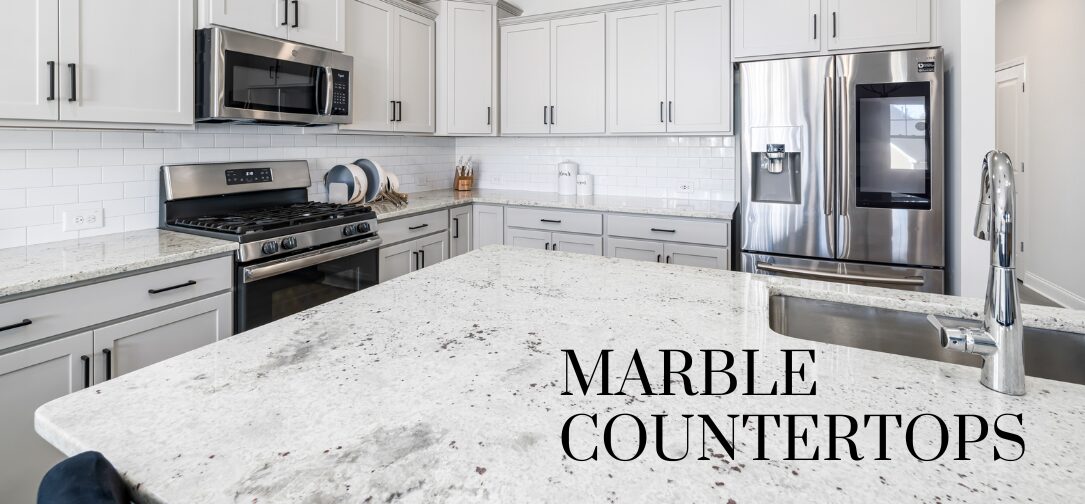Marble countertops have long been a symbol of style and elegance in home decoration. Opting for marble countertops elevates the sophistication of your kitchen and bathroom while combining beautifully with the existing style.
If you are curious about marble countertops and researching their possible disadvantages, you might have come across some incorrect information. This guide will help you learn more about common myths about marble countertops—debunked so that you can make the best-informed decision for your home.
Marble Is Too Delicate for Kitchens
While marble is considered to be a soft stone compared to alternatives such as quartzite or granite, that doesn’t mean it is not suitable for kitchen countertops. Marble has been used in kitchens for centuries and it is a favorite among homeowners and interior decorators for a reason.
On the contrary, marble is a great option for kitchens and can be used in a variety of ways such as countertops, kitchen island tops, backsplashes, coffee bars, and more. Of course, professionals recommend preventative measures such as always using cutting boards to ensure the longevity and the pristine condition of the stone.
Marble Is Impossible To Maintain
The myth about marble being impossible to maintain is an exaggeration that turns off many potential buyers of this luxurious stone. Yes, marble does require a few maintenance steps to make sure it can maintain its beauty and structural integrity, but these steps are no more than other natural stones.
For example, similar to other natural stones like granite or quartzite, marble is also porous. This means that it needs to be resealed yearly so that it can resist stains and bacteria. In addition, avoiding harsh chemicals and abrasive materials while cleaning the stone is always a safe choice.
Marble Is Easily Stained
As mentioned before, most natural stones have a porous surface that can allow spills and bacteria to seep into the stone and cause unsightly stains. This is a common concern and it can easily be avoided with a good sealer. Make sure that the sealer you are using is compatible with natural stones and that you are applying enough to offer full protection to the stone.
As a further precaution, you can pay close attention to the countertops and wipe the spills as soon as they happen. Drinks such as red wine or coffee are common culprits. Moreover, if you notice that the countertops are starting to lose their shine, this might be a sign that the sealer is wearing off and needs replenishing.
Marble And Granite Are The Same Thing
If you are new to the natural stone world, you might be unaware that marble and granite have many differences between them. Although they are both natural stones, their formation, composition, and qualities are very different.
Granite is harder than marble and is more resistant to scratches. On the other hand, marble possesses unique qualities such as keeping a cool temperature even in higher climates.
The choice between the two comes down to a personal preference between the signature looks of the stones. Neither of the stones is inferior to the other, they just offer different advantages that are beneficial to different homeowners.
Marble Is Out of Style
Marble is known for its timeless elegance and luxurious aura. The misconception about it being outdated is not only incorrect but it is the total opposite of the truth. Marble is a stone that has been in style for centuries. You can flip through any interior decoration magazine and see that marble countertops are still the star of the show.
Both homeowners and interior decorators love marble countertops because it is a versatile option with a wide range of colors and patterns that can be paired with any design style. It is both modern and classic, it is effortless while being stylish.
Marble Is Too Expensive
Marble comes in a vast array of price points. Higher-end marble slabs with unique colors or exotic patterns can be very expensive. In addition, if the slab is quarried overseas and needs lang-distance transportation, then the price tag will be even higher.
However, this doesn’t mean that all marble types are expensive. It is more expensive compared to countertop materials like laminate, but many affordable marble options can give you the stylish look you want to achieve while sticking to your budget. Its luxurious appearance contributes to one of the most common myths about marble countertops.
Marble Can’t Handle Heat
Marble is a naturally occurring metamorphic stone. It forms over millions of years under immense pressure and heat. This makes marble incredibly durable against heat, thus making it a great option for kitchen countertops.
You can place hot pans and pots on marble kitchen countertops without having to worry about the countertops getting thermal shock or scorch marks. While marble is incredibly resistant to heat, this doesn’t mean that is it completely heatproof. For this reason, professionals recommend the use of trivets, which might be the starting point for this myth.
Marble Slabs All Look The Same
When it comes to kitchen countertops, there are certain popular color palettes and styles. Most homeowners opt for light and neutral colors like cream and white so that the kitchen can look brighter.
While lighter colors are the most popular, that doesn’t mean other colors don’t exist. Brighter and bolder colors such as blue, green, red, pink, orange, and gold are available. If you want to add a subtle touch you can also opt for slight hues as well as dramatic splashes. In addition to colors, you can also choose between different patterns.
Marble Can’t Be Repaired
The misconception that marble can’t be repaired should be added to the list of common myths about marble countertops—debunked. You might be under the impression that once marble gets a scratch or stain, the blemish can’t be removed ever again.
In reality, marble can be repaired. Light scratches can be buffed out and polished. Depending on the severity, professionals can repair more serious damages. Even if the countertops are chipped along the edge, they can be filled in. In short, even if your marble countertops have small blemishes, don’t despair. It doesn’t mean the countertops are beyond saving.
Now that you are more knowledgeable about the common myths about marble countertops—debunked, you have a clear understanding of the advantages and disadvantages of marble countertops. Worries about maintenance steps or concerns about possible damages can be discouraging. While marble does require some care and attention, its beauty and durability make it all worth it.
Whether you are just browsing through different countertop material options or you are planning a complete renovation, don’t let these myths deter you. Armed with these facts, you can make the best-informed decision for your home.



































